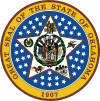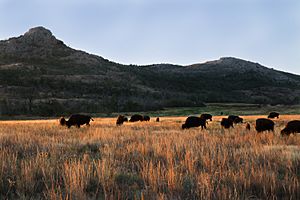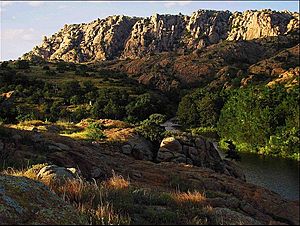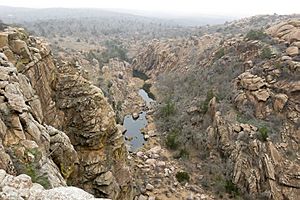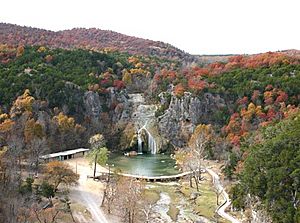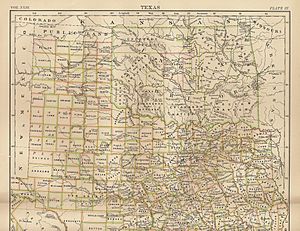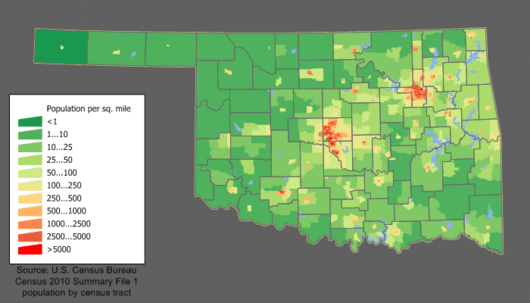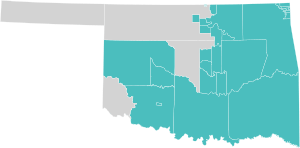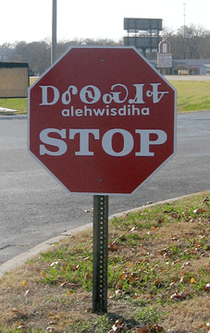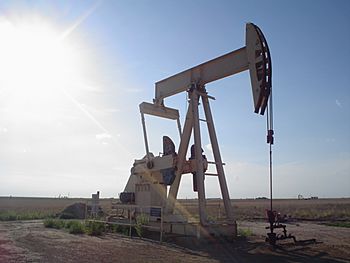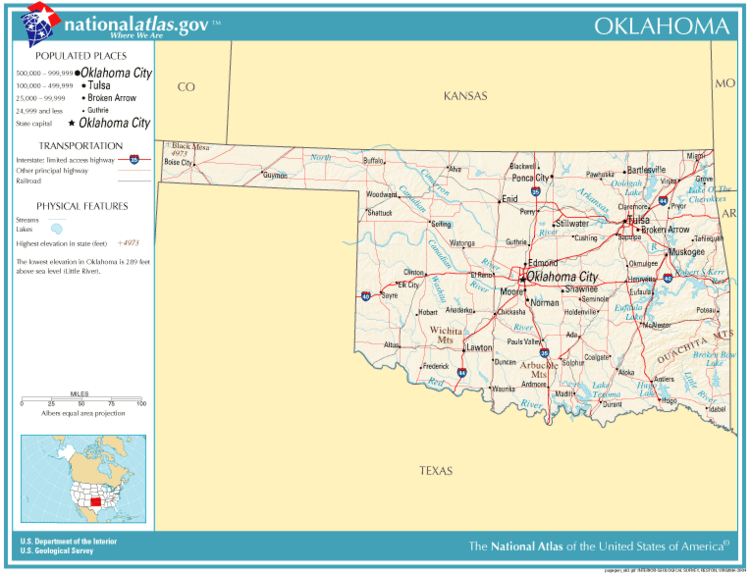Oklahoma facts for kids
Quick facts for kids
Oklahoma
Oklahumma (Choctaw)
|
|||
|---|---|---|---|
| State of Oklahoma | |||
|
|||
Nickname(s):
|
|||
| Motto(s):
Labor omnia vincit
(English: Work conquers all) |
|||
| Anthem: "Oklahoma" and "Oklahoma Hills" |
|||

Map of the United States with Oklahoma highlighted
|
|||
| Country | United States | ||
| Before statehood |
|
||
| Admitted to the Union | November 16, 1907 (46th) | ||
| Capital (and largest city) |
Oklahoma City | ||
| Largest metro | Greater Oklahoma City | ||
| Legislature | Oklahoma Legislature | ||
| • Upper house | Senate | ||
| • Lower house | House of Representatives | ||
| Area | |||
| • Total | 69,898 sq mi (181,038 km2) | ||
| • Land | 68,595 sq mi (177,660 km2) | ||
| • Water | 1,304 sq mi (3,377 km2) 1.9% | ||
| Area rank | 20th | ||
| Dimensions | |||
| • Length | 465 mi (749 km) | ||
| • Width | 230 mi (370 km) | ||
| Elevation | 1,300 ft (400 m) | ||
| Highest elevation | 4,975 ft (1,516 m) | ||
| Lowest elevation
(Little River at Arkansas border)
|
289 ft (88 m) | ||
| Population
(2020)
|
|||
| • Total | 3,963,516 | ||
| • Rank | 28th | ||
| • Density | 55.20/sq mi (21.30/km2) | ||
| • Density rank | 35th | ||
| • Median household income | $50,051 | ||
| • Income rank | 43rd | ||
| Demonym(s) | Oklahoman; Okie (colloq.); Sooner (historically) |
||
| Language | |||
| • Official language | English, Choctaw, Cherokee | ||
| Time zones | |||
| entire state (legally) | UTC−06:00 (Central) | ||
| • Summer (DST) | UTC−05:00 (CDT) | ||
| Kenton (informally) | UTC−07:00 (Mountain) | ||
| • Summer (DST) | UTC−06:00 (MDT) | ||
| USPS abbreviation |
OK
|
||
| ISO 3166 code | US-OK | ||
| Trad. abbreviation | Okla. | ||
| Latitude | 33°37' N to 37° N | ||
| Longitude | 94° 26' W to 103° W | ||
| Oklahoma state symbols | |
|---|---|
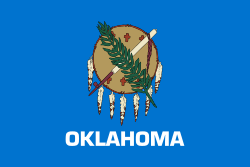
The Flag of Oklahoma
|
|
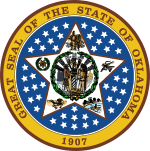
The Seal of Oklahoma
|
|
| Living insignia | |
| Amphibian | Bullfrog |
| Bird | Scissor-tailed Flycatcher |
| Fish | Sand bass |
| Flower |
|
| Grass | Indian Grass |
| Insect | European honey bee |
| Mammal | American bison |
| Reptile | Mountain Boomer |
| Tree | Redbud |
| Inanimate insignia | |
| Beverage | Milk |
| Colors | White and green (vice versa) |
| Dance | Waltz: Oklahoma Wind |
| Dinosaur | Acrocanthosaurus atokensis |
| Folk dance | Square dance |
| Fossil | Saurophaganax maximus |
| Instrument | Drum |
| Rock | Rose Rock |
| Soil | Port Silt Loam |
| Tartan | Oklahoma Tartan |
| Other |
|
| State route marker | |
 |
|
| State quarter | |

Released in 2008, as part of the state quarters series. Oklahoma's state bird flying above its state wildflower.
|
|
| Lists of United States state symbols | |
Oklahoma is a state in the South Central region of the United States, bordered by Texas on the south and west, Kansas on the north, Missouri on the northeast, Arkansas on the east, New Mexico on the west, and Colorado on the northwest. Partially in the western extreme of the Upland South, it is the 20th-most extensive and the 28th-most populous of the 50 United States. Its residents are known as Oklahomans (or colloquially "Okies"), and its capital and largest city is Oklahoma City.
The state's name is derived from the Choctaw words okla, 'people' and humma, which translates as 'red'. Oklahoma is also known informally by its nickname, "The Sooner State", in reference to the settlers who staked their claims on land before the official opening date of lands in the western Oklahoma Territory or before the Indian Appropriations Act of 1889, which increased European-American settlement in the eastern Indian Territory. Oklahoma Territory and Indian Territory were merged into the State of Oklahoma when it became the 46th state to enter the union on November 16, 1907.
With ancient mountain ranges, prairie, mesas, and eastern forests, most of Oklahoma lies in the Great Plains, Cross Timbers, and the U.S. Interior Highlands, all regions prone to severe weather. Oklahoma is at a confluence of three major American cultural regions. Historically it served as a government-sanctioned territory for Native Americans removed from east of the Mississippi River, a route for cattle drives from Texas and related regions, and a destination for Southern migrant settlers. There are currently twenty-five Native American languages still spoken in Oklahoma.
A major producer of natural gas, oil, and agricultural products, Oklahoma relies on an economic base of aviation, energy, telecommunications, and biotechnology. Oklahoma City and Tulsa serve as Oklahoma's primary economic anchors, with nearly two-thirds of Oklahomans living within their metropolitan statistical areas.
Contents
Geography
Oklahoma is the 20th-largest state in the United States, covering an area of 69,898 square miles (181,035 km2), with 68,667 square miles (177847 km2) of land and 1,281 square miles (3,188 km2) of water. It is one of six states on the Frontier Strip and lies partly in the Great Plains near the geographical center of the 48 contiguous states. It is bounded on the east by Arkansas and Missouri, on the north by Kansas, on the northwest by Colorado, on the far west by New Mexico, and on the south and near-west by Texas. Much of its border with Texas lies along the Southern Oklahoma Aulacogen, a failed continental rift. The geologic figure defines the placement of the Red River.
The Oklahoma panhandle's Western edge is out of alignment with its Texas border. The Oklahoma/New Mexico border is actually 2.1 to 2.2 miles east of the Texas line. The border between Texas and New Mexico was set first as a result of a survey by Spain in 1819. It was then set along the 103rd Meridian. In the 1890s, when Oklahoma was formally surveyed using more accurate surveying equipment and techniques, it was discovered the Texas line was not set along the 103rd Meridian. Surveying techniques were not as accurate in 1819, and the actual 103rd Meridian was approximately 2.2 miles to the east. It was much easier to leave the mistake than for Texas to cede land to New Mexico to correct the surveying error. The placement of the Oklahoma/New Mexico border represents the true 103rd Meridian.
Cimarron County in Oklahoma's panhandle is the only county in the United States that touches four other states: New Mexico, Texas, Colorado and Kansas.
Topography
Oklahoma is between the Great Plains and the Ozark Plateau in the Gulf of Mexico watershed, generally sloping from the high plains of its western boundary to the low wetlands of its southeastern boundary. Its highest and lowest points follow this trend, with its highest peak, Black Mesa, at 4,973 feet (1,516 m) above sea level, situated near its far northwest corner in the Oklahoma Panhandle. The state's lowest point is on the Little River near its far southeastern boundary near the town of Idabel, Oklahoma, which dips to 289 feet (88 m) above sea level.

Among the most geographically diverse states, Oklahoma is one of four to harbor more than 10 distinct ecological regions, with 11 in its borders – more per square mile than in any other state. Its western and eastern halves, however, are marked by extreme differences in geographical diversity: Eastern Oklahoma touches eight ecological regions and its western half contains three. Although having fewer ecological regions Western Oklahoma contains many rare, relic species.
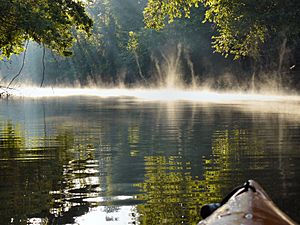
Oklahoma has four primary mountain ranges: the Ouachita Mountains, the Arbuckle Mountains, the Wichita Mountains, and the Ozark Mountains. Contained within the U.S. Interior Highlands region, the Ozark and Ouachita Mountains mark the only major mountainous region between the Rocky Mountains and the Appalachians. A portion of the Flint Hills stretches into north-central Oklahoma, and near the state's eastern border, Cavanal Hill is regarded by the Oklahoma Tourism & Recreation Department as the world's tallest hill; at 1,999 feet (609 m), it fails their definition of a mountain by one foot.
The semi-arid high plains in the state's northwestern corner harbor few natural forests; the region has a rolling to flat landscape with intermittent canyons and mesa ranges like the Glass Mountains. Partial plains interrupted by small, sky island mountain ranges like the Antelope Hills and the Wichita Mountains dot southwestern Oklahoma; transitional prairie and oak savannahs cover the central portion of the state. The Ozark and Ouachita Mountains rise from west to east over the state's eastern third, gradually increasing in elevation in an eastward direction.
More than 500 named creeks and rivers make up Oklahoma's waterways, and with 200 lakes created by dams, it holds the nation's highest number of artificial reservoirs. Most of the state lies in two primary drainage basins belonging to the Red and Arkansas rivers, though the Lee and Little rivers also contain significant drainage basins.
Flora and fauna
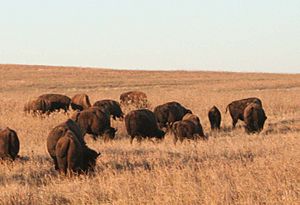
Due to Oklahoma's location at the confluence of many geographic regions, the state's climatic regions have a high rate of biodiversity for their size. Forests cover 24 percent of Oklahoma and prairie grasslands composed of shortgrass, mixed-grass, and tallgrass prairie, harbor expansive ecosystems in the state's central and western portions, although cropland has largely replaced native grasses. Where rainfall is sparse in the state's western regions, shortgrass prairie and shrublands are the most prominent ecosystems, though pinyon pines, red cedar (junipers), and ponderosa pines grow near rivers and creek beds in the panhandle's far western reaches. Southwestern Oklahoma contains many rare, disjunct species including sugar maple, bigtooth maple, nolina and southern live oak.
Marshlands, cypress forests and mixtures of shortleaf pine, loblolly pine, blue palmetto, and deciduous forests dominate the state's southeastern quarter, while mixtures of largely post oak, elm, red cedar (Juniperus virginiana) and pine forests cover northeastern Oklahoma.
The state holds populations of white-tailed deer, mule deer, antelope, coyotes, mountain lions, bobcats, elk, and birds such as quail, doves, cardinals, bald eagles, red-tailed hawks, and pheasants. In prairie ecosystems, American bison, greater prairie chickens, badgers, and armadillo are common, and some of the nation's largest prairie dog towns inhabit shortgrass prairie in the state's panhandle. The Cross Timbers, a region transitioning from prairie to woodlands in Central Oklahoma, harbors 351 vertebrate species. The Ouachita Mountains are home to black bear, red fox, grey fox, and river otter populations, which coexist with a total of 328 vertebrate species in southeastern Oklahoma. Also, in southeastern Oklahoma lives the American alligator.
Protected lands
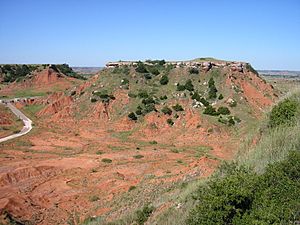
Oklahoma has 50 state parks, six national parks or protected regions, two national protected forests or grasslands, and a network of wildlife preserves and conservation areas. Six percent of the state's 10 million acres (40,000 km2) of forest is public land, including the western portions of the Ouachita National Forest, the largest and oldest national forest in the Southern United States.
With 39,000 acres (158 km2), the Tallgrass Prairie Preserve in north-central Oklahoma is the largest protected area of tallgrass prairie in the world and is part of an ecosystem that encompasses only 10 percent of its former land area, once covering 14 states. In addition, the Black Kettle National Grassland covers 31,300 acres (127 km2) of prairie in southwestern Oklahoma. The Wichita Mountains Wildlife Refuge is the oldest and largest of nine national wildlife refuges in the state and was founded in 1901, encompassing 59,020 acres (238.8 km2).
Of Oklahoma's federally protected park or recreational sites; the Chickasaw National Recreation Area is the largest, with 9,898.63 acres (18 km2). Other sites include the Santa Fe and Trail of Tears national historic trails, the Fort Smith and Washita Battlefield national historic sites, and the Oklahoma City National Memorial.
Climate

Oklahoma is located in a humid subtropical region. Oklahoma lies in a transition zone between humid continental climate to the north, semi-arid climate to the west, and humid subtropical climate in the central, south and eastern portions of the state.
Most of the state lies in an area known as Tornado Alley characterized by frequent interaction between cold, dry air from Canada, warm to hot, dry air from Mexico and the Southwestern U.S., and warm, moist air from the Gulf of Mexico. The interactions between these three contrasting air currents produces severe weather (severe thunderstorms, damaging thunderstorm winds, large hail and tornadoes) with a frequency virtually unseen anywhere else on planet Earth. An average 62 tornadoes strike the state per year — one of the highest rates in the world.
Because of Oklahoma's position between zones of differing prevailing temperature and winds, weather patterns within the state can vary widely over relatively short distances and can change drastically in a short time. As an example, on November 11, 1911, the temperature at Oklahoma City reached 83 °F (28 °C) in the afternoon (the record high for that date), then an Arctic cold front of unprecedented intensity slammed across the state, causing the temperature to crash 66 degrees, down to 17 °F (−8 °C) at midnight (the record low for that date); thus, both the record high and record low for November 11 were set on the same date. This type of phenomenon is also responsible for many of the tornadoes in the area, such as the 1912 Oklahoma tornado outbreak, when a warm front traveled along a stalled cold front, resulting in an average of about one tornado per hour over the course of a day.
Over almost all of Oklahoma, winter is the driest season. Average monthly precipitation increases dramatically in the spring to a peak in May, the wettest month over most of the state, with its frequent and not uncommonly severe thunderstorm activity. Early June can still be wet, but most years see a marked decrease in rainfall during June and early July. Mid-summer (July and August) represents a secondary dry season over much of Oklahoma, with long stretches of hot weather with only sporadic thunderstorm activity not uncommon many years. Severe drought is common in the hottest summers, such as those of 1934, 1954, 1980 and 2011, all of which featured weeks on end of virtual rainlessness and high temperatures well over 100 °F (38 °C). Average precipitation rises again from September to mid-October, representing a secondary wetter season, then declines from late October through December.
All of the state frequently experiences temperatures above 100 °F (38 °C) or below 0 °F (−18 °C), though below-zero temperatures are rare in south-central and southeastern Oklahoma. Snowfall ranges from an average of less than 4 inches (10 cm) in the south to just over 20 inches (51 cm) on the border of Colorado in the panhandle.
History
Evidence exists that indigenous peoples traveled through Oklahoma as early as the last ice age. Ancestors of the Wichita, Kichai, Teyas, Escanjaques, and Caddo lived in what is now Oklahoma. Southern Plains Villagers lived in the central and west of the state, with a subgroup, the Panhandle culture people living in panhandle region. Caddoan Mississippian culture peoples lived in the eastern part of the state. Spiro Mounds, in what is now Spiro, Oklahoma, was a major Mississippian mound complex that flourished between AD 850 and 1450.
The Spaniard Francisco Vásquez de Coronado traveled through the state in 1541, but French explorers claimed the area in the 1700s. In the 18th century, Kiowa, Apache, and Comanche entired the region from the west and Quapaw and Osage peoples moved into what is now eastern Oklahoma. French colonists claims the region until 1803, when all the French territory west of the Mississippi River was purchased by the United States in the Louisiana Purchase.
The territory now known as Oklahoma was first a part of the Arkansas Territory from 1819 until 1828.
During the 19th century, thousands of Native Americans were expelled from their ancestral homelands from across North America and transported to the area including and surrounding present-day Oklahoma. The Choctaw was the first of the Five Civilized Tribes to be removed from the southeastern United States. The phrase "Trail of Tears" originated from a description of the removal of the Choctaw Nation in 1831, although the term is usually used for the Cherokee removal.
A total of 17,000 Cherokees and 2,000 of their black slaves were deported. The area, already occupied by Osage and Quapaw tribes, was called for the Choctaw Nation until revised Native American and then later American policy redefined the boundaries to include other Native Americans. By 1890, more than 30 Native American nations and tribes had been concentrated on land within Indian Territory or "Indian Country".
All Five Civilized Tribes supported and signed treaties with the Confederate military during the American Civil War. The Cherokee Nation had an internal civil war. Slavery in Indian Territory was not abolished until 1866.
In the period between 1866 and 1899, cattle ranches in Texas strove to meet the demands for food in eastern cities and railroads in Kansas promised to deliver in a timely manner. Cattle trails and cattle ranches developed as cowboys either drove their product north or settled illegally in Indian Territory. In 1881, four of five major cattle trails on the western frontier traveled through Indian Territory.
Increased presence of white settlers in Indian Territory prompted the United States Government to establish the Dawes Act in 1887, which divided the lands of individual tribes into allotments for individual families, encouraging farming and private land ownership among Native Americans but expropriating land to the federal government. In the process, railroad companies took nearly half of Indian-held land within the territory for outside settlers and for purchase.
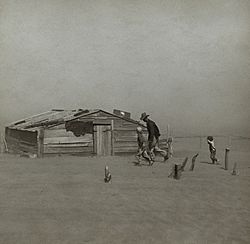
Major land runs, including the Land Run of 1889, were held for settlers where certain territories were opened to settlement starting at a precise time. Usually land was open to settlers on a first come first served basis. Those who broke the rules by crossing the border into the territory before the official opening time were said to have been crossing the border sooner, leading to the term sooners, which eventually became the state's official nickname.
Deliberations to make the territory into a state began near the end of the 19th century, when the Curtis Act continued the allotment of Indian tribal land.
20th and 21st centuries
Attempts to create an all-Indian state named Oklahoma and a later attempt to create an all-Indian state named Sequoyah failed but the Sequoyah Statehood Convention of 1905 eventually laid the groundwork for the Oklahoma Statehood Convention, which took place two years later. On November 16, 1907, Oklahoma was established as the 46th state in the Union.
The new state became a focal point for the emerging oil industry, as discoveries of oil pools prompted towns to grow rapidly in population and wealth. Tulsa eventually became known as the "Oil Capital of the World" for most of the 20th century and oil investments fueled much of the state's early economy. In 1927, Oklahoman businessman Cyrus Avery, known as the "Father of Route 66", began the campaign to create U.S. Route 66. Using a stretch of highway from Amarillo, Texas to Tulsa, Oklahoma to form the original portion of Highway 66, Avery spearheaded the creation of the U.S. Highway 66 Association to oversee the planning of Route 66, based in his hometown of Tulsa.
Oklahoma also has a rich African American history. There were many black towns that thrived in the early 20th century because of black settlers moving from neighboring states, especially Kansas. The politician Edward P. McCabe encouraged black settlers to come to what was then Indian Territory. He discussed with President Theodore Roosevelt the possibility of making Oklahoma a majority-black state.
By the early 20th century, the Greenwood neighborhood of Tulsa was one of the most prosperous African-American communities in the United States. Jim Crow laws had established racial segregation since before the start of the 20th century, but the blacks had created a thriving area.
During the 1930s, parts of the state began suffering the consequences of poor farming practices, extended drought and high winds. Known as the Dust Bowl, areas of Kansas, Texas, New Mexico and northwestern Oklahoma were hampered by long periods of little rainfall and abnormally high temperatures, sending thousands of farmers into poverty and forcing them to relocate to more fertile areas of the western United States. Over a twenty-year period ending in 1950, the state saw its only historical decline in population, dropping 6.9 percent as impoverished families migrated out of the state after the Dust Bowl.
Soil and water conservation projects markedly changed practices in the state and led to the construction of massive flood control systems and dams; they built hundreds of reservoirs and man-made lakes to supply water for domestic needs and agricultural irrigation. By the 1960s, Oklahoma had created more than 200 lakes, the most in the nation.
On May 31, 2016, several cities experienced record setting flooding.
Demographics
The people of Oklahoma, known as Okies, can be of any race or ethnicity. An Okie is a resident, native, or cultural descendant of Oklahoma.
Population
| Historical population | |||
|---|---|---|---|
| Census | Pop. | %± | |
| 1890 | 258,657 | — | |
| 1900 | 790,391 | 205.6% | |
| 1910 | 1,657,155 | 109.7% | |
| 1920 | 2,028,283 | 22.4% | |
| 1930 | 2,396,040 | 18.1% | |
| 1940 | 2,336,434 | −2.5% | |
| 1950 | 2,233,351 | −4.4% | |
| 1960 | 2,328,284 | 4.3% | |
| 1970 | 2,559,229 | 9.9% | |
| 1980 | 3,025,290 | 18.2% | |
| 1990 | 3,145,585 | 4.0% | |
| 2000 | 3,450,654 | 9.7% | |
| 2010 | 3,751,351 | 8.7% | |
| 2020 | 3,963,516 | 5.7% | |
| 2021 (est.) | 3,986,639 | 6.3% | |
| U.S. Decennial Census | |||
The United States Census Bureau estimates Oklahoma's population was 3,963,516 during the 2020 United States Census, a 5.66% increase since the 2010 United States Census.
In 2010, the center of population of Oklahoma was in Lincoln County near the town of Sparks.
The state's 2006 per capita personal income ranked 37th at $32,210, though it has the third-fastest-growing per capita income in the U.S. Oklahoma ranks consistently among the lowest states in cost of living index.
In 2011, 7.0% of Oklahomans were under the age of 5, 24.7% under 18, and 13.7% were 65 or older. Females made up 50.5% of the population.
Race and ethnicity
As of the 2010 Census, 72.2% of the population was white, 8.6% American Indian and Alaska Native, 7.4% black or African American, 1.7% Asian, 0.1% Native Hawaiian and Other Pacific Islander, 4.1% from some other race and 5.9% of two or more races. 8.9% of Oklahoma's population were of Hispanic, Latino, or Spanish origin (they may be of any race).
| Racial composition | 1940 | 1970 | 1990 | 2010 |
|---|---|---|---|---|
| White | 90.1% | 89.1% | 81% | 72.2% |
| Hispanic | – | – | 2.7% | 8.9% |
| Native | 2.7% | 3.8% | 8% | 8.6% |
| Black | 7.2% | 6.7% | 7.4% | 7.4% |
| Asian (Included Pacific Islanders before 1990) |
- | 0.1% | 1.1% | 1.7% |
| Native Hawaiian and other Pacific Islander |
– | – | – | 0.1% |
| Other race | – | 0.2% | 1.3% | 4.1% |
| Two or more races | – | – | – | 5.9% |
| Racial composition | 2010 | 2020 |
|---|---|---|
| White | 77.5% | 75.5% |
| Hispanic | 8.9% | 11.9% |
| Native | 12.9% | 16% |
| Black | 8.7% | 9.7% |
| Asian | 2.2% | 3.1% |
| Native Hawaiian and other Pacific Islander |
0.2% | 0.4% |
| Other race | 4.7% | 9% |
In 2005, Oklahoma's estimated ancestral makeup was 14.5% German, 13.1% American, 11.8% Irish, 9.6% English, 8.1% African American, and 11.4% Native American (including 7.9% Cherokee) though the percentage of people claiming American Indian as their only race was 8.1%. Most people from Oklahoma who self-identify as having American ancestry are of overwhelmingly English and Scots-Irish ancestry with significant amounts of Scottish, Welsh and Irish inflection as well.
In 2011, 47.3% of Oklahoma's population younger than age 1 were minorities, meaning they had at least one parent who was not non-Hispanic white.
In 2011, U.S. Census Bureau American Community Survey data from 2005 to 2009 indicated about 5% of Oklahoma's residents were born outside the United States. This is lower than the national figure (about 12.5% of U.S. residents were foreign-born).
Cities and towns
The state is in the U.S. Census' Southern region. According to the 2020 United States Census, Oklahoma is the 28th-most populous state with 3,963,516 inhabitants but the 19th-largest by land area spanning 68,594.92 square miles (177,660.0 km2) of land. In 2010, Oklahoma was divided into 77 counties and contains 597 incorporated municipalities consisting of cities and towns.
In Oklahoma, cities are all those incorporated communities which are 1,000 or more in population and are incorporated as cities. Towns are limited to town board type of municipal government. Cities may choose among aldermanic, mayoral, council-manager, and home-rule charter types of government. Cities may also petition to incorporate as towns.
The Oklahoma City suburb Nichols Hills is first on Oklahoma locations by per capita income at $73,661, though Tulsa County holds the highest average.
|
Largest cities or towns in Oklahoma
Source (2020): |
||
|---|---|---|
| Rank | Name | Pop. |
| 1 | Oklahoma City | 681,054 |
| 2 | Tulsa | 413,066 |
| 3 | Norman | 128,026 |
| 4 | Broken Arrow | 113,540 |
| 5 | Edmond | 94,428 |
| 6 | Lawton | 90,381 |
| 7 | Moore | 62,793 |
| 8 | Midwest City | 58,409 |
| 9 | Enid | 51,308 |
| 10 | Stillwater | 48,394 |
Language
English
The English language has been official in the state of Oklahoma since 2010. The variety of North American English spoken is called Oklahoma English, and this dialect is quite diverse with its uneven blending of features of North Midland, South Midland, and Southern dialects. In 2000, 2,977,187 Oklahomans—92.6% of the resident population, five years or older—spoke only English at home, a decrease from 95% in 1990. 238,732 Oklahoma residents reported speaking a language other than English at home in the 2000 census, about 7.4% of the state's population.
Native American languages
The two most commonly spoken native North American languages are Cherokee and Choctaw with 10,000 Cherokee speakers living within the Cherokee Nation tribal jurisdiction area of eastern Oklahoma, and another 10,000 Choctaw speakers living in the Choctaw Nation directly south of the Cherokees. Cherokee is an official language in the Cherokee Nation tribal jurisdiction area and in the United Keetoowah Band of Cherokee Indians.
Twenty-five Native American languages are spoken in Oklahoma, second only to California. However, only Cherokee, if any, exhibits some language vitality at present. Ethnologue sees Cherokee as moribund because the only remaining active users of the language are members of the grandparent generation and older.
Other languages
| Language | Percentage of population (as of 2000[update]) |
|---|---|
| Spanish | 4.4% |
| Native North American languages | 0.6% |
| German and Vietnamese (tied) | 0.4% |
| French | 0.3% |
| Chinese | 0.2% |
| Korean, Arabic, Tagalog, Japanese (tied) | 0.1% |
Spanish is the second-most commonly spoken language in the state, with 141,060 speakers counted in 2000. German has 13,444 speakers representing about 0.4% of the state's population, and Vietnamese is spoken by 11,330 people, or about 0.4% of the population, many of whom live in the Asia District of Oklahoma City. Other languages include French with 8,258 speakers (0.3%), Chinese with 6,413 (0.2%), Korean with 3,948 (0.1%), Arabic with 3,265 (0.1%), other Asian languages with 3,134 (0.1%), Tagalog with 2,888 (0.1%), Japanese with 2,546 (0.1%), and African languages with 2,546 (0.1%).
Religion
Oklahoma is part of a geographical region characterized by conservative and Evangelical Christianity known as the "Bible Belt". Spanning the southern and eastern parts of the United States, the area is known for politically and socially conservative views, with the Republican Party having the greater number of voters registered between the two parties. Tulsa, the state's second-largest city, home to Oral Roberts University, is sometimes called the "buckle of the Bible Belt".
In 2000, there were about 5,000 Jews and 6,000 Muslims, with ten congregations to each group.
According to the Pew Research Center in 2008, the majority of Oklahoma's religious adherents were Christian, accounting for about 80 percent of the population. The percentage of Catholics was half the national average, while the percentage of Evangelical Protestants was more than twice the national average (tied with Arkansas for the largest percentage of any state).

In 2010, the state's largest church memberships were in the Southern Baptist Convention (886,394 members), the United Methodist Church (282,347), the Roman Catholic Church (178,430), and the Assemblies of God (85,926) and The Church of Jesus Christ of Latter-day Saints (Mormons) (47,349). Other religions represented in the state include Buddhism, Hinduism, and Islam.
According to the Pew Research Center in 2014, the majority of Oklahoma's religious adherents were Christian accounting for 79 percent of the population, 9 percent higher than the national average. The percentage of Evangelical Protestants declined since the last study, but they remain the largest religious group in the state at 47 percent, over 20 percent higher than the national average. The largest growth over the six years between Pew's 2008 and 2014 survey was in the number of people who identify as Unaffiliated in the state with an increase of 6 percent.
| Religion | 2008 | 2014 |
|---|---|---|
| Evangelical Protestant | 53% | 47% |
| Mainline Protestant | 16% | 18% |
| Historically Black Protestant | 3% | 4% |
| Catholic | 12% | 8% |
| Mormon | <0.5% | 1% |
| Orthodox Christianity | <0.5% | <1% |
| Jehovah's Witness | <0.5% | <1% |
| Other Christians | 1% | <1% |
| Jewish | 1% | <1% |
| Muslim | <0.5% | <1% |
| Buddhist | 1% | <1% |
| Hindu | <0.5% | <1% |
| Other World Faiths | <0.5% | <1% |
| Unaffiliated, Atheist, Agnostic, and nothing in particular | 12% | 18% |
| Unitarians, Humanists, Deists, Spiritual but not religious, Eclectic, and "other liberal faiths" | No data | <1% |
| New Age religion, Pagans or Wiccan | No data | <1% |
| Native American religions | No data | <1% |
| Don't Know | 1% | 1% |
Incarceration
Oklahoma has been described as "the world's prison capital", with 1,079 of every 100,000 residents imprisoned in 2018, the highest incarceration rate of any state, and by comparison, higher than the incarceration rates of any country in the world.
Cities and towns
Major cities

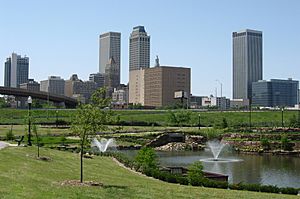
Oklahoma"s Most Populous Cities
- Oklahoma City - 599,199
- Tulsa - 393,987
- Norman - 115,562
- Broken Arrow - 102,019
- Lawton - 98,376
- Edmond - 84,885
- Moore - 57,810
- Midwest City - 56,080
- Enid - 49,854
- Stillwater - 46,560
- Muskogee - 38,981
- Bartlesville - 36,245
Economy

Oklahoma is host to a diverse range of sectors including aviation, energy, transportation equipment, food processing, electronics, and telecommunications. Oklahoma is an important producer of natural gas, aircraft, and food. The state ranks third in the nation for production of natural gas, is the 27th-most agriculturally productive state, and also ranks 5th in production of wheat. Four Fortune 500 companies and six Fortune 1000 companies are headquartered in Oklahoma, and it has been rated one of the most business-friendly states in the nation, with the 7th-lowest tax burden in 2007.
- Total employment (2018): 1,385,228
- Number of employer establishments: 93,561
In 2010, Oklahoma City-based Love's Travel Stops & Country Stores ranked 18th on the Forbes list of largest private companies, Tulsa-based QuikTrip ranked 37th, and Oklahoma City-based Hobby Lobby ranked 198th in 2010 report. Oklahoma's gross domestic product grew from $131.9 billion in 2006 to $147.5 billion in 2010, a jump of 10.6 percent. Oklahoma's gross domestic product per capita was $35,480 in 2010, which was ranked 40th among the states.
Though oil has historically dominated the state's economy, a collapse in the energy industry during the 1980s led to the loss of nearly 90,000 energy-related jobs between 1980 and 2000, severely damaging the local economy. Oil accounted for 35 billion dollars in Oklahoma's economy in 2007, and employment in the state's oil industry was outpaced by five other industries in 2007. As of September 2020[update], the state's unemployment rate is 5.3%.
Industry
In mid-2011, Oklahoma had a civilian labor force of 1.7 million and non-farm employment fluctuated around 1.5 million. The government sector provides the most jobs, with 339,300 in 2011, followed by the transportation and utilities sector, providing 279,500 jobs, and the sectors of education, business, and manufacturing, providing 207,800, 177,400, and 132,700 jobs, respectively. Among the state's largest industries, the aerospace sector generates $11 billion annually.
Tulsa is home to the largest airline maintenance base in the world, which serves as the global maintenance and engineering headquarters for American Airlines. In total, aerospace accounts for more than 10 percent of Oklahoma's industrial output, and it is one of the top 10 states in aerospace engine manufacturing. Because of its position in the center of the United States, Oklahoma is also among the top states for logistic centers, and a major contributor to weather-related research.
The state is the top manufacturer of tires in North America and contains one of the fastest-growing biotechnology industries in the nation. In 2005, international exports from Oklahoma's manufacturing industry totaled $4.3 billion, accounting for 3.6 percent of its economic impact. Tire manufacturing, meat processing, oil and gas equipment manufacturing, and air conditioner manufacturing are the state's largest manufacturing industries.
Energy
Oklahoma is the nation's third-largest producer of natural gas, and its fifth-largest producer of crude oil. The state also has the second-greatest number of active drilling rigs, and it is even ranked fifth in crude oil reserves. While the state was ranked eighth for installed wind energy capacity in 2011, it still was at the bottom of states in usage of renewable energy in 2009, with 94% of its electricity being generated by non-renewable sources in 2009, including 25% from coal and 46% from natural gas.
Ten years later in 2019, 53.5% of electricity was produced from natural gas and 34.6% from wind power.
Oklahoma has no nuclear power plants. Ranking 13th for total energy consumption per capita in 2009, the state's energy costs were eighth-lowest in the nation.
As a whole, the oil energy industry contributes $35 billion to Oklahoma's gross domestic product (GDP), and employees of the state's oil-related companies earn an average of twice the state's typical yearly income. In 2009, the state had 83,700 commercial oil wells churning 65.374 million barrels (10,393,600 m3) of crude oil. 8.5% of the nation's natural gas supply is held in Oklahoma, with 1.673 trillion cubic feet (47.4 km3) being produced in 2009.
The Oklahoma Stack Play is a geographic referenced area in the Anadarko Basin. The oil field "Sooner Trend", Anadarko basin and the counties of Kingfisher and Canadian make up the basis for the "Oklahoma STACK". Other Plays such as the Eagle Ford are geological rather than geographical.
According to Forbes magazine, Oklahoma City-based Devon Energy Corporation, Chesapeake Energy Corporation, and SandRidge Energy Corporation are the largest private oil-related companies in the nation, and all Oklahoma's Fortune 500 companies are energy-related. Tulsa's ONEOK and Williams Companies are the state's largest and second-largest companies respectively, also ranking as the nation's second- and third-largest companies in the field of energy, according to Fortune magazine. The magazine also placed Devon Energy as the second-largest company in the mining and crude oil-producing industry in the nation, while Chesapeake Energy ranks seventh respectively in that sector and Oklahoma Gas & Electric ranks as the 25th-largest gas and electric utility company.
Oklahoma Gas & Electric, commonly referred to as OG&E (NYSE: OGE) operates four base electric power plants in Oklahoma. Two of them are coal-fired power plants: one in Muskogee, and the other in Red Rock. Two are gas-fired power plants: one in Harrah and the other in Konawa. OG&E was the first electric company in Oklahoma to generate electricity from wind farms in 2003.
Wind generation
Agriculture
The 27th-most agriculturally productive state, Oklahoma is fifth in cattle production and fifth in production of wheat. Approximately 5.5 percent of American beef comes from Oklahoma, while the state produces 6.1 percent of American wheat, 4.2 percent of American pig products, and 2.2 percent of dairy products.
The state had 85,500 farms in 2012, collectively producing $4.3 billion in animal products and fewer than one billion dollars in crop output with more than $6.1 billion added to the state's gross domestic product. Poultry and swine are its second- and third-largest agricultural industries.
Culture
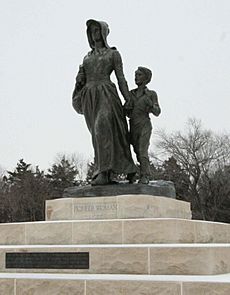
Because many Native Americans were forced to move to Oklahoma when White settlement in North America increased, Oklahoma has high levels of language endangerment.
Six governments have claimed the area now known as Oklahoma at different times, and 67 Native American tribes are represented in Oklahoma, including 39 federally recognized tribes, who are headquartered and have tribal jurisdictional areas in the state. Western ranchers, Native American tribes, southern settlers, and eastern oil barons have shaped the state's cultural predisposition, and its largest cities have been named among the most underrated cultural destinations in the United States.
Residents of Oklahoma are associated with traits of southern hospitality – the 2006 Catalogue for Philanthropy (with data from 2004) ranks Oklahomans 7th in the nation for overall generosity. The state has also been associated with a negative cultural stereotype first popularized by John Steinbeck's novel The Grapes of Wrath, which described the plight of uneducated, poverty-stricken Dust Bowl-era farmers deemed "Okies". However, the term is often used in a positive manner by Oklahomans.
Arts and theater

In the state's largest urban areas, pockets of jazz culture flourish, and Native American, Mexican American, and Asian American communities produce music and art of their respective cultures. The Oklahoma Mozart Festival in Bartlesville is one of the largest classical music festivals on the southern plains, and Oklahoma City's Festival of the Arts has been named one of the top fine arts festivals in the nation.
The state has a rich history in ballet with five Native American ballerinas attaining worldwide fame.
The Philbrook Museum of Tulsa is considered one of the top 50 fine art museums in the United States, and the Sam Noble Oklahoma Museum of Natural History in Norman, one of the largest university-based art and history museums in the country, documents the natural history of the region. The collections of Thomas Gilcrease are housed in the Gilcrease Museum of Tulsa, which also holds the world's largest, most comprehensive collection of art and artifacts of the American West.
The Egyptian art collection at the Mabee-Gerrer Museum of Art in Shawnee is considered to be the finest Egyptian collection between Chicago and Los Angeles. The Oklahoma City Museum of Art contains the most comprehensive collection of glass sculptures by artist Dale Chihuly in the world, and Oklahoma City's National Cowboy and Western Heritage Museum documents the heritage of the American Western frontier. With remnants of the Holocaust and artifacts relevant to Judaism, the Sherwin Miller Museum of Jewish Art of Tulsa preserves the largest collection of Jewish art in the Southwest United States.
Festivals and events

Oklahoma's centennial celebration was named the top event in the United States for 2007 by the American Bus Association, and consisted of multiple celebrations saving with the 100th anniversary of statehood on November 16, 2007. Annual ethnic festivals and events take place throughout the state such as Native American powwows and ceremonial events, and include festivals (as examples) in Scottish, Irish, German, Italian, Vietnamese, Chinese, Czech, Jewish, Arab, Mexican and African-American communities depicting cultural heritage or traditions.
During a 10-day run in Oklahoma City, the State Fair of Oklahoma attracts roughly one million people along with the annual Festival of the Arts. Large national pow-wows, various Latin and Asian heritage festivals, and cultural festivals such as the Juneteenth celebrations are held in Oklahoma City each year. The Tulsa State Fair attracts over one million people during its 10-day run, and the city's Mayfest festival entertained more than 375,000 people in four days during 2007. In 2006, Tulsa's Oktoberfest was named one of the top 10 in the world by USA Today and one of the top German food festivals in the nation by Bon Appetit magazine.
Norman plays host to the Norman Music Festival, a festival that highlights native Oklahoma bands and musicians. Norman is also host to the Medieval Fair of Norman, which has been held annually since 1976 and was Oklahoma's first medieval fair. The Fair was held first on the south oval of the University of Oklahoma campus and in the third year moved to the Duck Pond in Norman until the Fair became too big and moved to Reaves Park in 2003. The Medieval Fair of Norman is Oklahoma's "largest weekend event and the third-largest event in Oklahoma, and was selected by Events Media Network as one of the top 100 events in the nation".
Transportation
Transportation in Oklahoma is generated by an anchor system of Interstate Highways, inter-city rail lines, airports, inland ports, and mass transit networks. Situated along an integral point in the United States Interstate network, Oklahoma contains three primary Interstate highways and four auxiliary Interstate Highways. In Oklahoma City, Interstate 35 intersects with Interstate 44 and Interstate 40, forming one of the most important intersections along the United States highway system.
More than 12,000 miles (19,000 km) of roads make up the state's major highway skeleton, including state-operated highways, ten turnpikes or major toll roads, and the longest drivable stretch of Route 66 in the nation. In 2008, Interstate 44 in Oklahoma City was Oklahoma's busiest highway, with a daily traffic volume of 123,300 cars. In 2010, the state had the nation's third-highest number of bridges classified as structurally deficient, with nearly 5,212 bridges in disrepair, including 235 National Highway System Bridges.
Oklahoma's largest commercial airport is Will Rogers World Airport in Oklahoma City, averaging a yearly passenger count of more than 3.5 million (1.7 million boardings) in 2010. Tulsa International Airport, the state's second-largest commercial airport, served more than 1.3 million boardings in 2010. Between the two, six airlines operate in Oklahoma. In terms of traffic, R. L. Jones Jr. (Riverside) Airport in Tulsa is the state's busiest airport, with 335,826 takeoffs and landings in 2008. Oklahoma has more than 150 public-use airports.
Oklahoma is connected to the nation's rail network via Amtrak's Heartland Flyer, its only regional passenger rail line. It currently stretches from Oklahoma City to Fort Worth, Texas, though lawmakers began seeking funding in early 2007 to connect the Heartland Flyer to Tulsa.
Two inland ports on rivers serve Oklahoma: the Port of Muskogee and the Tulsa Port of Catoosa. The Tulsa Port of Catoosa is the one of the United States' most inland international ports, at head of navigation of the McClellan–Kerr Arkansas River Navigation System, which connects barge traffic from Tulsa and Muskogee to the Mississippi River. The port ships over two million tons of goods annually and is a designated foreign trade zone.
State symbols
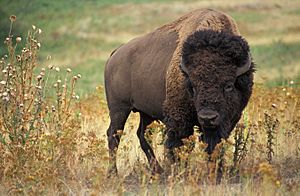
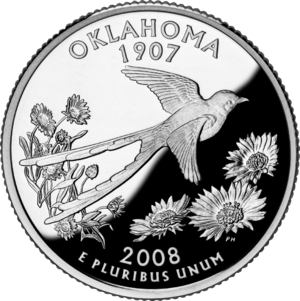
State law codifies Oklahoma's state emblems and honorary positions; the Oklahoma Senate or House of Representatives may adopt resolutions designating others for special events and to benefit organizations. Currently the State Senate is waiting to vote on a change to the state's motto. The House passed HCR 1024, which will change the state motto from "Labor Omnia Vincit" to "Oklahoma-In God We Trust!" The author of the resolution stated that a constituent researched the Oklahoma Constitution and found no "official" vote regarding "Labor Omnia Vincit", therefore opening the door for an entirely new motto.
State symbols:
- State cartoon: Gusty Created by Don Woods, Oklahoma's first professional meteorologist, used on KTUL-TV from 1954–1989.
- State bird: Scissor-tailed flycatcher
- State tree: Eastern redbud
- State mammal: American bison
- State beverage: Milk
- State fruit: Strawberry
- State vegetable: Watermelon
- State game bird: Wild turkey
- State fish: Sand bass
- State floral emblem: Mistletoe
- State flower: Oklahoma rose
- State wildflower: Indian blanket (Gaillardia pulchella)
- State grass: Indiangrass (Sorghastrum nutans)
- State fossil: Saurophaganax maximus
- State rock: Rose rock
- State insect: Honeybee
- State soil: Port Silt Loam
- State reptile: Collared lizard
- State amphibian: Bullfrog
- State meal: Fried okra, squash, cornbread, barbecue pork, biscuits, sausage and gravy, grits, corn, strawberries, chicken fried steak, pecan pie, and black-eyed peas.
- State folk dance: Square dance
- State percussive instrument: Drum
- State waltz: "Oklahoma Wind"
- State butterfly: Black swallowtail
- State song: "Oklahoma!"
- State language: English; Cherokee and other Native American languages
- State gospel song: "Swing Low, Sweet Chariot"
- State rock song: "Do You Realize??" by The Flaming Lips
Other pages
Education

With an educational system made up of public school districts and independent private institutions, Oklahoma had 638,817 students enrolled in 1,845 public primary, secondary, and vocational schools in 533 school districts as of 2008[update]. Oklahoma has the highest enrollment of Native American students in the nation with 126,078 students in the 2009–10 school year. Oklahoma spent $7,755 for each student in 2008, and was 47th in the nation in expenditures per student, though its growth of total education expenditures between 1992 and 2002 ranked 22nd.
The state is among the best in pre-kindergarten education, and the National Institute for Early Education Research rated it first in the United States with regard to standards, quality, and access to pre-kindergarten education in 2004, calling it "a model for early childhood schooling". High school dropout rate decreased from 3.1 to 2.5 percent between 2007 and 2008 with Oklahoma ranked among 18 other states with 3 percent or less dropout rate. In 2004, the state ranked 36th in the nation for the relative number of adults with high school diplomas, though at 85.2 percent, it had the highest rate among Southern states. According to a study conducted by the Pell Institute, Oklahoma ranks 48th in college-participation for low-income students.
The University of Oklahoma, Oklahoma State University, the University of Central Oklahoma, and Northeastern State University are the largest public institutions of higher education in Oklahoma, each operating through one primary campus and satellite campuses throughout the state. The two state universities, along with Oklahoma City University and the University of Tulsa, rank among the country's best in undergraduate business programs.
Oklahoma City University School of Law, University of Oklahoma College of Law, and University of Tulsa College of Law are the state's only ABA-accredited institutions. Both University of Oklahoma and University of Tulsa are Tier 1 institutions, with the University of Oklahoma ranked 68th and the University of Tulsa ranked 86th in the nation.
Oklahoma holds eleven public regional universities, including Northeastern State University, the second-oldest institution of higher education west of the Mississippi River, also containing the only College of Optometry in Oklahoma and the largest enrollment of Native American students in the nation by percentage and amount. Langston University is Oklahoma's only historically black college. Six of the state's universities were placed in the Princeton Review's list of best 122 regional colleges in 2007, and three made the list of top colleges for best value. The state has 55 post-secondary technical institutions operated by Oklahoma's CareerTech program for training in specific fields of industry or trade.
In the 2007–2008 school year, there were 181,973 undergraduate students, 20,014 graduate students, and 4,395 first-professional degree students enrolled in Oklahoma colleges. Of these students, 18,892 received a bachelor's degree, 5,386 received a master's degree, and 462 received a first professional degree. This means the state of Oklahoma produces an average of 38,278-degree-holders per completions component (i.e. July 1, 2007 – June 30, 2008). National average is 68,322 total degrees awarded per completions component.
Beginning on April 2, 2018, tens of thousands of K–12 public school teachers went on strike due to lack of funding. According to the National Education Association, teachers in Oklahoma had ranked 49th out of the 50 states in terms of teacher pay in 2016. The Oklahoma Legislature had passed a measure a week earlier to raise teacher salaries by $6,100, but it fell short of the $10,000 raise for teachers, $5,000 raise for other school employees, and $200 million increase in extra education funding many had sought. A survey in 2019 found that the pay raise obtained by the strike lifted the State's teacher pay ranking to 34th in the nation.
Non-English education

The Cherokee Nation instigated a ten-year plan in 2005 that involved growing new speakers of the Cherokee language from childhood as well as speaking it exclusively at home. The plan was part of an ambitious goal that in fifty years would have at least 80% of their people fluent. The Cherokee Preservation Foundation has invested $3 million into opening schools, training teachers, and developing curricula for language education, as well as initiating community gatherings where the language can be actively used. A Cherokee language immersion school in Tahlequah, Oklahoma educates students from pre-school through eighth grade.
Images for kids
-
Map of the Confederate States with allied tribes (in present-day Oklahoma)
-
The bombing of the Alfred P. Murrah Federal Building in Oklahoma City was one of the deadliest acts of terrorism in American history.
-
The Oklahoma City Thunder moved there in 2008, becoming its first permanent major-league team in any sport.
See also
 In Spanish: Oklahoma para niños
In Spanish: Oklahoma para niños



